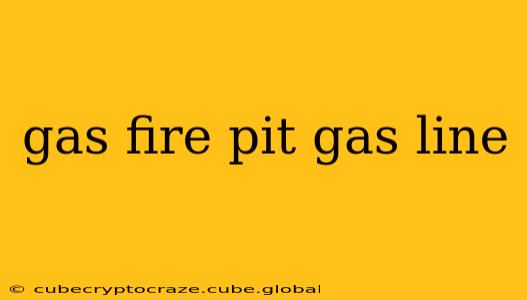Building a cozy and inviting atmosphere in your outdoor space is easy with a gas fire pit. However, the installation and maintenance of the gas line connecting your fire pit to your gas supply are critical for both safety and longevity. This comprehensive guide covers everything you need to know about gas fire pit gas lines, from installation best practices to essential safety checks and ongoing maintenance.
What Size Gas Line Do I Need for My Gas Fire Pit?
The size of the gas line needed for your gas fire pit depends entirely on the BTU (British Thermal Unit) output of your fire pit. Higher BTU outputs require larger diameter gas lines to safely and efficiently deliver the necessary gas. Consult your fire pit's owner's manual; it will specify the minimum gas line diameter required. Improper sizing can lead to insufficient gas flow, poor performance, and potential safety hazards. If you're unsure, consult a qualified gas fitter.
Can I Install a Gas Line for a Fire Pit Myself?
While some homeowners are comfortable tackling DIY projects, installing a gas line for a fire pit is generally not recommended unless you possess significant experience with gas line installation and are familiar with local building codes and safety regulations. Improper installation can lead to gas leaks, fires, and explosions, posing serious risks to you and your property. Always prioritize safety and hire a licensed and insured gas fitter for professional installation.
How Much Does It Cost to Install a Gas Line for a Fire Pit?
The cost of installing a gas line for your fire pit varies greatly depending on several factors:
- Distance from the gas supply: Longer distances require more materials and labor.
- Terrain: Difficult terrain (e.g., rocky areas, slopes) increases the cost.
- Local regulations: Permitting fees and inspections can add to the overall expense.
- Materials: The type and quality of the gas line materials will impact the cost.
Expect to pay anywhere from a few hundred dollars to several thousand dollars for professional gas line installation. Getting multiple quotes from licensed professionals is always recommended.
What Type of Gas Line is Used for a Fire Pit?
Typically, black iron pipe (also known as steel pipe) or flexible corrugated stainless steel tubing (CSST) is used for gas fire pit installations. Black iron pipe is durable and reliable but requires more precise fitting and skilled installation. CSST is more flexible, making it easier to navigate around obstacles, but it requires special fittings and may need additional grounding depending on local codes. Your gas fitter will determine the most suitable option for your specific circumstances.
How Often Should I Inspect My Gas Fire Pit Gas Line?
Regular inspection of your gas line is crucial for safety. Visually inspect your gas line regularly, looking for signs of damage, corrosion, leaks, or loose connections. Check for any discoloration, cracks, or rust on the pipe or fittings. It's recommended to perform a thorough visual inspection at least once a year, or more frequently if you notice any unusual sounds or smells. If you detect any issues, immediately shut off the gas supply and contact a qualified gas fitter for repairs.
What are the Safety Precautions When Using a Gas Fire Pit?
Beyond regular gas line inspections, remember these critical safety precautions:
- Never leave a gas fire pit unattended.
- Keep children and pets a safe distance from the fire pit.
- Ensure adequate ventilation.
- Follow the manufacturer's instructions carefully.
- Know how to quickly shut off the gas supply in case of an emergency.
- Have a fire extinguisher readily available.
By following these guidelines and prioritizing professional installation and regular maintenance, you can enjoy the warmth and ambiance of your gas fire pit safely and for years to come. Remember, safety should always be your top priority when dealing with gas appliances.
